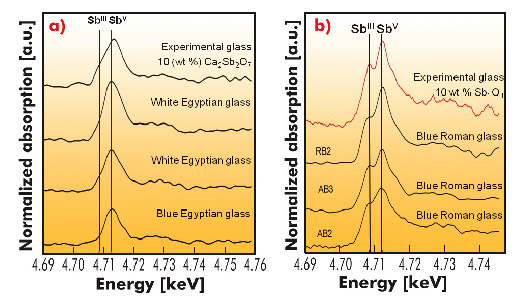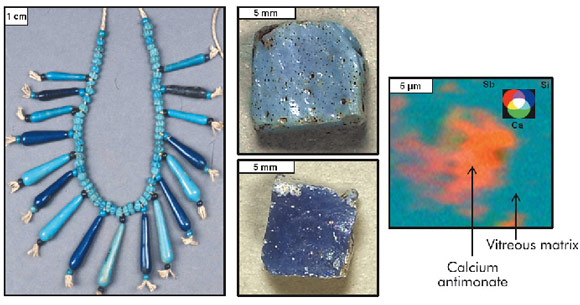- Home
- Users & Science
- Scientific Documentation
- ESRF Highlights
- ESRF Highlights 2010
- X-ray imaging
- Opacification of Egyptian and Roman glass
Opacification of Egyptian and Roman glass
During the Egyptian 18th dynasty and the Roman period, opaque coloured glass was extensively used to produce artifacts such as precious jewels or mosaic tesserae (Figure 133). These white, blue or turquoise glasses were opacified by white calcium antimonate crystals dispersed in a vitreous soda-lime-silica matrix. The difference in refractive index between the two phases prevents light from being completely transmitted and leads to the opacification of the glass.
Glass opacification generally relies on two main processes. The first involves the addition of natural or ex situ synthesised crystals to a translucent glass. The second relies on the introduction of antimony as an oxide or a sulphide into glass. This leads to the in situ crystallisation of opacifying agents through the separation from the melt of calcium antimonate crystals.
The common assumption is that calcium antimonates (CaSb2O6 and/or Ca2Sb2O7) were obtained by in situ crystallisation in both Egyptian and Roman glass. However, questions still remain on the technology and provenance of the opacifiers. Contributing to an in-depth knowledge of ancient glass opacification process was the key objective of this study.
Our study focussed on the investigation of the crystals and the vitreous matrices. The oxidation state of antimony in the vitreous matrices and the opacifiers was measured for the first time in opaque Egyptian glass from the 18th dynasty (1592-1270 B.C.) and in Roman mosaic tesserae from Aquilea and Rome (1st cent. B.C.- 6th cent. A.D.). Additionally, opaque glasses with a composition close to archaeological glasses were synthesised under controlled conditions in the laboratory. These synthetic glasses were compared to ancient glasses using appropriate micro-analytical techniques that have never been used before on this type of material: micro X-ray fluorescence mapping (µ-XRF) and micro X-ray absorption near edge spectroscopy (µ-XANES), carried out at beamline ID21. The synchrotron-based sub-micrometric measurements proved to be very well suited to measuring selectively the antimony oxidation state in the vitreous matrix (Figure 133). The latter, when combined with the microstructural observations and the crystalline phases identification, is one of the key parameters for the determination of the opacification process and the source of antimony employed.
Contrary to existing beliefs, it was demonstrated that Egyptian glassmakers were able to synthesise ex situ calcium antimonate compounds that do not exist in nature, which were subsequently added to the glass as opacifiers (Figure 134a). Egyptian blue and green pigments were the only high temperature compounds known to have been synthesised in Ancient Egypt. Our results show that calcium antimonate glass opacifiers were also synthetic compounds, providing further evidence for the sophisticated chemistry of this civilisation.
In Roman glasses, not only the in situ crystallisation process was confirmed but also the ratio SbIII/SbV measured in the vitreous matrices indicates that Sb2O4 could have been used as an antimony source (Figure 134b). This finding suggests that a first step of roasting natural stibnite (Sb2S3) or metallic antimony was made on antimony containing raw materials before introducing them into the glass, and it provides further evidence of the remarkable know-how of Roman craftsmen.
 |
|
Fig. 134: µ-XANES spectra performed at the Sb LI edge (average of five measurements) on the vitreous matrices. a) Egyptian white and blue glasses from the 18th dynasty (1570-1292 B.C.) and experimental glass opacified by addition of 10 wt% Ca2Sb2O7 to a translucent glass; b) Blue opaque Roman mosaic tesserae from Aquilea and Rome (1st cent. B.C.- 6th cent. A.D.). |
This work demonstrates that µ-XANES measurements provide invaluable information about glass opacification processes. This new approach exploiting the high spatial resolution, low detection limit and high chemical sensitivity provided at the ID21 X-ray microscope is the starting point for new discoveries on ancient glass technology.
Principal publications and authors
S. Lahlil (a), I. Biron (a), M. Cotte (a, b), J. Susini (b) and N. Menguy (c), Applied Physics A 98, 1-8 (2010); S. Lahlil (a), I. Biron (a), M. Cotte (a, b) and J. Susini (b), Applied Physics A 100, 683-692 (2010).
(a) C2RMF Centre of Research and Restoration of the French Museums –UMR 171 CNRS, Paris (France)
(b) ESRF
(c) IMPMC Institut de Minéralogie et de Physique des Milieux Condensés - UMR 7590 CNRS, UPMC, UDD, IPGP Paris (France)




